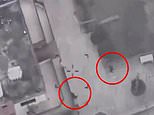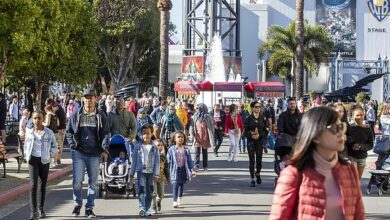Hezbollah, IDF trade missile strikes and Iran accuses Israel of ‘mass murder’ as US, UN, Russia plead for restraint with Middle East on brink of all-out regional war


WHAT IS THE ORIGIN OF HEZBOLLAH?
Iran’s Revolutionary Guards founded Hezbollah in 1982 during the 1975–90 Lebanese Civil War, as part of Tehran’s attempt to export the 1979 Islamic Revolution and combat Israeli forces that had invaded Lebanon in 1982. The group has grown from a shadowy faction into a heavily armed force with wide influence in Lebanon and the region. Western governments, including the United States, designate it as a terrorist group. So do Sunni Muslim Gulf states, including Saudi Arabia.
Hezbollah is a Shiite Islamist group that shares the ideology of the Islamic Republic of Iran.
HOW DID HEZBOLLAH BECOME INVOLVED IN THE GAZA WAR?
Hezbollah is a powerful part of the Axis of Resistance, an alliance of Iranian-backed groups in the Middle East that includes the Palestinian Islamist movement Hamas, which sparked the war in Gaza by attacking Israel on October 7. Hezbollah declared solidarity with the Palestinians and began firing on Israeli positions along the border on October 8. Since then, the sides have exchanged fire almost daily, with Hezbollah firing rockets and drones and Israel launching air and artillery strikes. The attacks have mostly taken place near or on the border, but both sides have also expanded their attacks.
Tens of thousands of people have been displaced in Lebanon and Israel.
HOW POWERFUL IS HEZBOLLAH’S ARMY?
While other groups disarmed after Lebanon’s civil war, Hezbollah kept its weapons to fight Israeli forces occupying the country’s predominantly Shiite Muslim south. Years of guerrilla warfare led to Israel’s withdrawal in 2000, but Hezbollah kept its arsenal.
Hezbollah made military advances in a five-week war with Israel in 2006. The war broke out after Hezbollah crossed the border into Israel, kidnapping two soldiers and killing others.
Hezbollah fired thousands of rockets into Israel during the conflict, killing 1,200 people in Lebanon, mostly civilians, and 158 Israelis, mostly soldiers.
Hezbollah’s military power grew after 2006. The group says its rockets can hit all parts of Israel and that its arsenal includes precision missiles. During the Gaza war, Hezbollah announced attacks with surface-to-air missiles — a weapon long thought to be in its arsenal but never confirmed. It has also fired explosive drones into Israel.
Hezbollah leader Sayyed Hassan Nasrallah has said the group has 100,000 fighters. According to the U.S. Central Intelligence Agency’s World Factbook, Hezbollah is estimated to have 45,000 fighters in 2022, divided into about 20,000 full-time and 25,000 reserve personnel.
WHAT REGIONAL POWER DOES HEZBOLLAH HAVE?
Hezbollah has inspired and supported other Iranian-backed groups in the region, including Iraqi Shiite militias. It played a major role in helping its ally President Bashar al-Assad wage war in Syria, where it still has fighters. Saudi Arabia says Hezbollah has also fought in support of the Iranian-backed Houthis in Yemen. Hezbollah denies this.
WHAT IS THE ROLE OF HEZBOLLAH IN LEBANON?
Hezbollah’s influence is bolstered by both its weapons and the support of many Lebanese Shiites who say the group defends Lebanon from Israel. It has ministers in the government and lawmakers in parliament.
Lebanese parties opposed to Hezbollah claim the group has undermined the state and unilaterally dragged Lebanon into wars.
The party entered Lebanese politics in 1992 and participated in elections. In 2005, the party began to play a more important role in state affairs after Syria withdrew its troops from Lebanon following the assassination of former Prime Minister Rafik al-Hariri, a Sunni politician who had become a symbol of Saudi Arabia’s influence in Beirut.
A UN-backed court convicted three Hezbollah members in absentia for the killing. Hezbollah denies any role and describes the court as a tool of its enemies.
In 2008, a power struggle between Hezbollah and its Lebanese political opponents led to armed conflict after the government promised to take action against the group’s military communications network. Hezbollah fighters took over parts of Beirut.
In 2018, Hezbollah and its allies who support its gun control won a parliamentary majority, which they lost in 2022, but the group still wields significant political influence.
ACCUSED OF ATTACKS ON WESTERN INTERESTS
Lebanese officials and Western intelligence agencies have said that groups linked to Hezbollah carried out suicide attacks on Western embassies and targets in the 1980s and kidnapped Westerners.
The United States holds Hezbollah responsible for suicide bombings in 1983 that destroyed the U.S. Marine Corps headquarters in Beirut, killing 241 troops, and a French barracks, killing 58 French paratroopers. It also says Hezbollah was behind a suicide bombing at the U.S. Embassy in Beirut in 1983.
Regarding the attacks and hostage-taking, Hezbollah leader Hassan Nasrallah said in a 2022 interview that they were carried out by small groups unaffiliated with Hezbollah.
Hezbollah has also been accused of militant attacks elsewhere. Argentina blames it and Iran for the deadly bombing of a Jewish community center in Buenos Aires that killed 85 people in 1994 and for an attack on the Israeli embassy in Buenos Aires in 1992 that killed 29.
Source: Reuters




